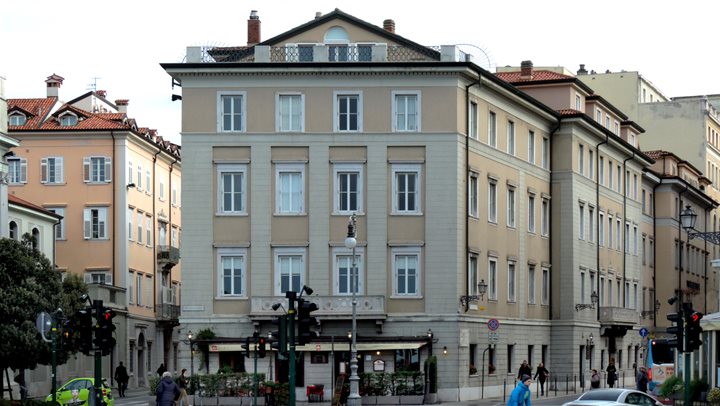Caffè Tommaseo
In 1824, in the trapezoid block between the Church of St. Nicholas of Greece and the rear façade of the Stock Exchange building (now Chamber of Commerce), Arch. Antonio Buttazzoni (1800 – 1848) designed two adjacent properties, on behalf of Felice and Vitale Vivante, characterised by an extremely simple compositional grid inspired by the neoclassical style.
The façade facing the banks was to have a convex circular structure, similar to the solution adopted by Buttazzoni's master, Matteo Pertsch, for the Rotonda Pancera of Via Venezian.
During the construction, completed in 1925, a flat façade was chosen instead, subsequently enriched with an “iron scaffold for the curtain”.
In 1830, the ownership of that property portion was transferred from Felice Vivante to Countess Lipona (the alleged pseudonym of Carolina Bonaparte, the widow of Gioacchino Murat) and in the same year it was leased as cafeteria to Tommaso Marcato from Padua, with the sign “Caffè Tommaso”, that in 1844 was one of the first buildings of the city to use gas lighting.
The interior decorations and stuccoes were made by painter Giuseppe Gatteri, while the mirrors came from Belgium. The name of the first café operator, Tommaso Marcato, is engraved on the 1839 pendulum clock.
After the uprisings of 1848, the name was changed into “Caffè Tommaseo”, as a tribute to the Dalmatian writer and patriot, in whose memory a series of mementos (a portrait and some copies of his works) are still kept in a showcase in the café.
As a proof of the link between the Café and that special historical moment there is a commemorative plaque, placed there by the National Institute for the History of the Risorgimento, stating: “From this Caffè Tommaseo, core of the national movement in 1848, the flame of enthusiasm for the Italian freedom spread”.
The Café – that from 1882 to 1918 after the murder of Guglielmo Oberdan returned to the old sign “Caffè Tommaso” - soon became the favourite destination of traders, bankers, journalists of the “Favilla”, lawyers and especially artists and scholars.
An exhibition for Giuseppe Bernardino Bison is worth mentioning, as well as some customers of this historic café, the oldest in Trieste, such as Stendhal (from 1830 to 1831 as French consul), Besenghi degli Ughi, Italo Svevo, James Joyce, Giani Stuparich, Pierantonio Quarantotti Gambini, Umberto Saba, Fulvio Tomizza, Claudio Magris.
The café went through several restorations, the most recent of which being in 1983 and 1997, and currently offers a restaurant service and a room to host painting exhibitions, small concerts and other cultural events.










